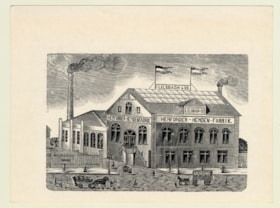Narrow Results By
I. Elsbach Herford Shirt Factory
https://www.cjhn.ca/link/cjhn75215
- Collection
- MONTREAL HOLOCAUST MEMORIAL CENTRE (MHMC-01)
- Description Level
- Item
- Material Type
- graphic material
- Physical Description
- Print : Ht: 12 cm x W: 16 cm
- Collection
- MONTREAL HOLOCAUST MEMORIAL CENTRE (MHMC-01)
- Description Level
- Item
- Material Type
- graphic material
- Physical Description
- Print : Ht: 12 cm x W: 16 cm
- Other Title Information
- Advertising Medium
- Physical Condition
- Excellent
- Language
- German
- Notes
- Print of an etching in black ink on white paper. Illustration of the Herforder Hemdenfabrik (Herford shirt factory) building with chimneys blowing smokes and horses pulling carriages inscribed with the name of the factory. Narrative: Brothers Josef and Hermann Elsbach founded the company in 1873 and in 1875 registered it as Herforder shirt factory J.Elsbach & Co. The founders came from a Jewish family in the clothing business since 1848. In 1907 Elsbach became a corporation. In 1914 the company was regarded as Europe's largest clothing company. More than 1,200 factory workers and thousands of home workers were employed. As part of the forced aryanizations of 1938, the family had to sell their shares. The company was taken over and renamed by Ahlers AG Herford linen factories. At the end of the Second World War, the factory buildings were heavily damaged by fire and looting. The military government in the British zone of occupation confiscated the shares of Ahlers in the company. In 1947, Ahlers came back to run the company but he died in1954. From 1952 the company was called back Elsbach linen factories AG. The shares were returned to the surviving heirs of the Elsbach family.
- Accession No.
- 2010.07.08
- Name Access
- Maass, Joan
- Archival / Genealogical
- Archival Descriptions
- Repository
- Montreal Holocaust Museum
Images
Photograph
https://www.cjhn.ca/link/cjhn113340
- Collection
- MONTREAL HOLOCAUST MEMORIAL CENTRE (MHMC-01)
- Description Level
- Item
- Material Type
- graphic material
- Physical Description
- Photograph : silver print ; Ht: 13,5 cm x W: 8,5 cm
- Date
- October 27, 1948
- Collection
- MONTREAL HOLOCAUST MEMORIAL CENTRE (MHMC-01)
- Description Level
- Item
- Material Type
- graphic material
- Physical Description
- Photograph : silver print ; Ht: 13,5 cm x W: 8,5 cm
- Date
- October 27, 1948
- Language
- German
- English
- Notes
- Black and white photo of the memorial for the Warsaw Ghetto in 1948. Jagged outline. Narrative: Sonia Smolnik-Aronowicz-Tencer was born in 1915, in Vilnius, formerly part of Poland. Her family has lived in Vilnius for many generations. She was married to a lawyer named Misha Aronowicz and studied to become an accountant. The city was under the Soviet occupation when the Nazis invaded on June 22, 1941. In September 1941, Sonia and her family were deported to the Vilnius ghetto, created by the Nazis to dehumanize and exploit the Jews. They remained there until 1943, when the men and women were separated. It was the last time she saw her brother, Ariye, and her husband, Misha. In the ghetto of Vilnius, Sonia befriended Miriam and Minya (Miriam's sister-in-law). Together, they made a pact to help each other survive the war. Their friendship and alliance represent a form of resistance against the abuse they suffered in the ghetto and labor camps. The same year, Sonia's parents went into hiding. Sonia and her two friends were then deported to the concentration camps of Riga-Kaiserwald and Riga-Strasdenhof in Latvia where they were used as forced labor. In 1945, they were deported to Bromberg-Ost, a women's annex of the Stutthof concentration camp where they were forced to build German railroads and barracks. The camp was liquidated on January 20, 1945, 300 survivors set off on a death march to Sachsenhausen-Oranienburg. Sonia managed to escape. She spent the next few weeks hiding in abandoned German houses before her liberation by the Soviet Army. On the day of her liberation near Pomerania, a Soviet soldier gave Sonia a necklace as a symbol of hope and comfort. He told her she would be able to wear jewelry again one day. After the war, Sonia reunited with her two friends. Miriam then immigrated to Boston where she became an administrative assistant in the Chemistry Department at Harvard. Minya remained in France, where she married and had two sons. Sonia arrived in Canada aboard the ship Samaria in 1950.
- Accession No.
- 2020.10.03
- Name Access
- Tencer, Naomi
- Archival / Genealogical
- Archival Descriptions
- Repository
- Montreal Holocaust Museum
Images
{{ server.message }}



